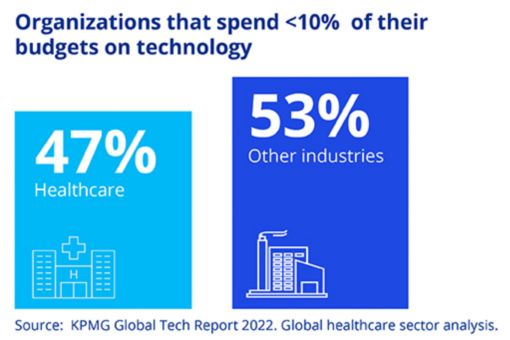Preview
Technology will be vital in supporting healthcare industry transformation that consumers are demanding, and system leaders and payors know is so badly needed. This article examines how healthcare organizations are investing in and deriving value from technology, how Web 3.0 and the metaverse may transform the sector, and the core capabilities needed to support virtual and immersive healthcare models.
Given the current and future challenges the healthcare sector is facing globally, it’s time to take a hard look at how healthcare systems are operated to help ensure they are meeting the needs of citizens and are sustainable in the long term. KPMG firms propose that an inclusive approach to transformation should be taken through which technology, communities and workforces are leveraged together, a philosophy that is laid out in detail in the Healthcare Horizons global thought leadership report.1 An ‘inclusive’ approach is one in which healthcare organizations thrive and populations can expect to benefit from improved health and care. In this scenario, technology empowers individuals and communities in a more fundamental way, not solely the organizations that provide it. Technology is seen as a means to an end – activating patients in their own care, enabling healthcare workers to better engage with patients, and empowering communities to address health inequity issues and employ more preventative approaches.
Given that technology will be key in supporting transformation at what will likely be a watershed time in the history of the sector, it would be prudent to examine the current state of investment healthcare organizations are making in technology. Healthcare organizations are not big spenders on technology relative to those in other industries. The KPMG Global Tech Report 2022 surveyed more than 2,000 technology leaders from 11 industries. This report revealed that 47 percent of healthcare organizations devote less than 10 percent of their budget to technology, versus 53 percent of all organizations. Yet healthcare organizations are getting good results for the money they do spend. Fifty-eight percent of healthcare industry respondents indicated that they have been very or extremely effective in using digital technology to advance their organizational strategies compared to 60 percent across other industries.2
Based on other KPMG research from 2021, it was found that health leaders are focusing their investments first on data-generating, analyzing, and supporting technology – the tools and platforms that help document and transmit patient data, support in clinical decision-making, and enable patient navigation.3 In line with patient-centric, community-based care, these technologies help set up a digital front door for service delivery.
When looking towards technology trends that are expected to impact society, that digital front door may increasingly lead to care being delivered in an immersive virtual world. As the world’s largest technology firms shift their focus to investment in Web 3.0, the principles and technologies that underpin it are expected to revolutionize healthcare. Web 3.0 is viewed as an upgrade to — or the next generation of — the internet, in which today’s ‘read and write’ model is replaced by a ‘read, write and own’ model that makes it more democratic and decentralized. A key part of this new internet is expected to be the metaverse, where physical and digital realities collide, creating a borderless realm that has the potential to enhance people’s lives by providing new opportunities to work, learn and play through the use of virtual and augmented reality.
Indicators in the United States bear this out. The metaverse healthcare market size is expected to increase to US$72.10 billion by 2030 from the current US$6.85 billion.4 New care models are already gathering momentum. In the last two years, the number of facilities in the United States providing care by telepresence has more than doubled from 43 percent to 95 percent.5
Predicted impact of Web 3.0 and the metaverse on healthcare
Web 3.0 and the metaverse have the potential to transform healthcare in a number of ways:
- Data ownership and use: How data is stored, owned and used in Web 3.0 shifts from governments, companies and organizations, to individuals, giving them greater agency over their data. Individuals will be able to store their health data from multiple sources in personal online data stores (PODS). These decentralized forms of online data storage will offer greater levels of security, privacy and control for individuals. PODs will also offer a solution to healthcare providers, alleviating the issue of interoperability between systems and the burden of protecting huge quantities of patient data.
Individuals will likely have the opportunity to pool their data in decentralized autonomous organizations (DAOs). These member-owned and led organizations allow virtual communities to control what happens to their data democratically through a system of discussion and voting. DAOs can choose to trade or monetize their data, use their data to improve health outcomes and/or to address health inequities, in accordance with the wishes of their membership. - Borderless delivery: The metaverse will likely support the emergence of a new range of digital healthcare providers that are no longer bound by the constraints of physical infrastructure or geography. Telepresence can also empower patients to seek out clinicians without regard to their physical location, enabling greater choice and access to leading expertise for those who can navigate and afford this new paradigm. Traditional barriers to virtual consultations requiring physical contact have the potential to be disrupted by accelerating adoption of haptic and mixed-reality technologies such as Microsoft Mesh.6 The borderless nature of the metaverse, combined with the ability to use new payment methods like cryptocurrencies, and the portability of personally controlled health information, may create further opportunities for global service markets to emerge.
Emergence of virtual hospitals
Latus Health Ltd, a UK-based firm specializing in occupational health, has flagged the potential development of a virtual hospital in the metaverse. Initially, the company intends to offer remote physiotherapy and counseling services via a virtual reality (VR) headset. Physiotherapy will feature computer vision (a field of computer science that enables processing and analysis of visual data in a human-like manner), providing a more accurate measurement of progress and recovery versus a conventional setting. Capturing and using visual data, for example to measure improvement in the range of movement in a joint, provides feedback on the efficacy of an intervention and could drive both better adherence to a therapeutic regimen and enhanced motivation for patients.7
- Inclusivity: The virtual nature of the metaverse environment has the potential to confer significant benefits associated with the de-stigmatization of health conditions, particularly in mental health and sexual health.8
- Predictive and personalized care: As technologies mature and the volume and quality of data increases, digital twins (virtual representations of patients) offer potential for providers and patients alike to better consider and predict likely outcomes. This change is likely to be accelerated by the increasing prevalence of genetic screening and targeted therapies for both healthcare and naturopathic uses.9
With virtual and immersive care models, health systems will likely see their spending on technology rise, but this may be offset by a decline in spending on estate, buildings, and workforces as hospital-based care shifts to new settings, including virtual and community-based environments.
Healthcare organizations looking to implement virtual and immersive care models will likely need digitally enabled technology architecture guided by a clear commitment to a ‘digital-first’ approach, robust IT service management, and an unstinting focus on information security and active management of soaring cyber threats. The ability to deliver seamless interactions across evolving ecosystems will be key along with having a skilled and digitally enabled workforce that is actively engaged in strategy and delivery.
Key takeaways
- Historically, healthcare organizations have not been big spenders on technology relative to organizations in other industries, this is expected to change as the industry increasingly responds to unprecedented challenges and emerging technology trends.
- Web 3.0 and the metaverse have the potential to transform healthcare in the way that data is owned, stored and used, creating opportunities for borderless delivery of services and supporting predictive and personalized care.
- To implement virtual and immersive care models, healthcare organizations will likely require a digitally enabled architecture, robust and secure IT services management, and digitally skilled and supported workforces who can deliver seamless experiences to consumers.
1 KPMG International. (2023). Healthcare Horizons. https://kpmg.com/xx/en/home/insights/2023/01/healthcare-horizons.html
2 KPMG International. (2022) KPMG Global Tech Report 2022. Global healthcare sector analysis (unpublished).
3 KPMG International. (2021). Healthcare CEO Future Pulse. The digital journey—from data and delivery to AI and robotics.
https://kpmg.com/xx/en/home/insights/2021/06/the-digital-journey-from-data-and-delivery-to-ai-and-robotics.html
4 Precedence Research. (2022). Metaverse in Healthcare Market.
5 Marr, B. (2022 February). The amazing possibilities of healthcare in the metaverse. Forbes.com.
6 Microsoft. (2023). Mesh for Microsoft Teams. Microsoft.com.
7 Marr, B. (2022 February). The amazing possibilities of healthcare in the metaverse. Forbes.com.
8 University Hospitals. (2020). Could telehealth be the answer to stigma removal for behavioral health.
9 Life Labs. (2020). Innovating for cancer treatment and prevention: LifeLabs Community Report. LifeLabs.com.




